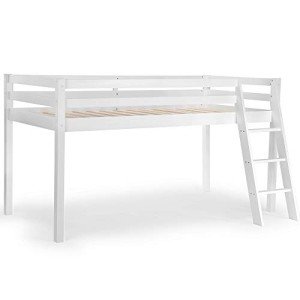10 Reasons Why People Hate Bunk Beds Children's. Bunk Beds Children's
The Ultimate Guide to Bunk Beds for Children: Safety, Styles, and Benefits
When it comes to styling a kid's room, parents typically face the double difficulty of optimizing space while guaranteeing convenience and performance. Bunk beds have actually emerged as a popular solution that attends to these needs, providing not just sleeping plans but likewise adding to a space's visual. In this extensive guide, we will explore different aspects of kids's bunk beds, concentrating on their benefits, safety features, designs, and considerations for parents pondering this purchase.
Tabulation
- Benefits of Bunk Beds
- Security Features to Consider
- Types of Bunk Beds
- Design and Style Options
- Maintenance Tips
- Regularly Asked Questions (FAQs)
1. Advantages of Bunk Beds
Bunk beds provide many benefits for children and their parents. Here are some crucial advantages:
Space-Efficiency: Bunk beds are an outstanding option for smaller sized rooms. By stacking one bed on top of another, more flooring space is available for play, storage, or study locations.
Cost-efficient: When kids share spaces, bunk beds can reduce the need for purchasing 2 separate beds, thus saving money.
Promotes Social Interaction: Bunk beds can help siblings or pals bond by sharing a space, producing chances for social development.
Fun Factor: The principle of sleeping “up high” adds a spirited aspect to bedtime, making the transition to sleeping alone simpler for some children.
Versatile Design: Bunk beds are available in various styles, colors, and designs to match any space theme, enabling personalization that reflects the child's personality.
2. Security Features to Consider
Security is paramount when it concerns children's furniture, especially when it comes to bunk beds. Here are some critical safety features to examine:
Safety Feature
Description
Tough Construction
Frames made from strong wood or metal are chosen.
Guardrails
Need to be at least 5 inches high and extend along both sides of the upper bunk.
Ladder Design
Make sure ladders are firmly connected and have non-slip actions.
Mattress Size & & Fit
Must fit comfortably within the frame to prevent spaces.
Weight Limit
Always adhere to the manufacturer's weight limit suggestions.
3. Kinds Of Bunk Beds
Bunk beds come in a number of designs, dealing with different requirements, preferences, and space sizes. Here are some common types:
Standard Bunk Bed: The many standard type, with one bed on top of another.
Loft Bed: Features a high upper bed with space underneath for a desk or play area.
Futon Bunk Bed: Combines a leading bunk with a futon on the bottom, supplying flexibility for seating and sleeping.
L-Shaped Bunk Bed: This style has the leading bunk set at a perpendicular angle to the bottom, developing a little corner area.
Triple Bunk Bed: Accommodates 3 kids utilizing stacked beds, ideal for big households or sleepovers.
4. Style and Style Options
When it concerns choosing a design for kids's bunk beds, the options are virtually endless. Here are some popular designs:
Traditional Style: Often made from wood, these bunk beds feature elaborate details and are perfect for classic or rustic-themed rooms.
Modern Style: Characterized by clean lines and minimalist styles, contemporary bunk beds can be made of metal or wood.
Themed Bunk Beds: Some brand names offer bunk beds shaped like castles, cars, or playhouses, making bedtime less of a chore.
Convertible Bunk Beds: These can be separated into 2 individual beds, offering flexibility as kids grow.
Colorful Options: Bunk beds in vibrant colors can add a sense of joy and playfulness to any room.
5. Maintenance Tips
Maintaining a bunk bed is vital for durability and security. Here are some tips:
Regular Inspections: Check for loose screws or bolts every couple of months and tighten them as required.
Cleaning: Wipe down frames regularly to avoid dust accumulation; consider utilizing a vacuum for hard-to-reach areas.
Mattress Care: Rotate mattresses frequently and use protective covers to prolong their life.
Expect Wear and Tear: Look for any signs of damage in the wood or metal and think about replacing parts if needed.
Teach Kids Safety Rules: Encourage children to utilize ladders appropriately and ensure they understand the safety features of their bed.
6. Regularly Asked Questions (FAQs)
Q1: What age is suitable for oversleeping a leading bunk?
A1: Typically, children aged 6 and older are advised for upper bunk sleeping, as they have the necessary motor abilities to climb safely.
Q2: Do bunk beds include a mattress?
A2: Most bunk beds are offered as frames only, so you will need to purchase mattresses separately. Make sure that the mattress fits the frame snugly.
Q3: Can bunk beds be separated later?
A3: Many designs enable conversion into two private beds, supplying versatility for future requirements.
Q4: How can I ensure my kid's security on a bunk bed?
A4: Comply with security standards and make sure guardrails, a durable frame, and a protected ladder remain in place.
Q5: Are there weight limits on bunk beds?
A5: Yes, always inspect the manufacturer's specifications relating to weight limitations to make sure safety.
Bunk beds for children can serve multiple purposes while ensuring security and style. With varied Bunk Beds For Kids and designs offered on the market, parents can discover a system that not just takes full advantage of bed room space but also shows their kid's special tastes. As with any furniture, comprehending security features, upkeep, and how they fit into a child's way of life will ensure that these beds stay a useful furniture solution for many years to come.
Through cautious consideration and adherence to safety standards, bunk beds can offer a long-lasting, fun, and functional sleeping option that children love.
